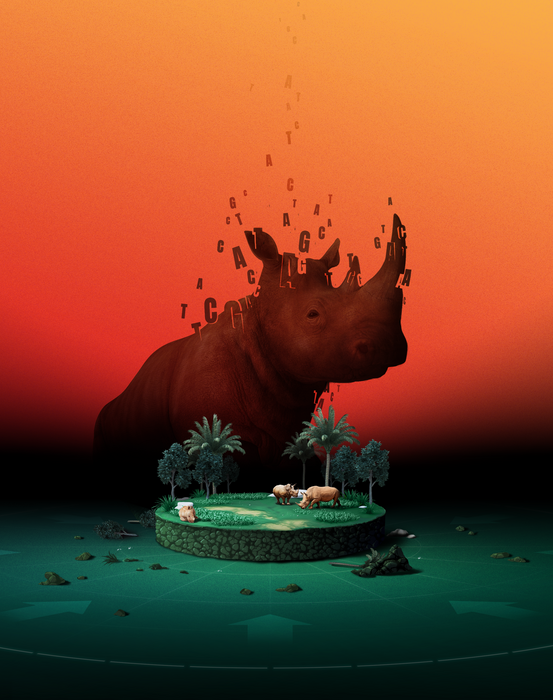Palo Alto, CA—Climate change and habitat destruction may have already caused the loss of more than one-tenth of the world’s terrestrial genetic diversity, according to new research led by Carnegie’s Moises Exposito-Alonso and published in Science. This means that it may already be too late to meet the United Nations’ proposed target, announced last year, of protecting 90 percent of genetic diversity for every species by 2030, and that we have to act fast to prevent further losses.

Credit: Artwork is courtesy of Mark Belan | artscistudios.com.
Palo Alto, CA—Climate change and habitat destruction may have already caused the loss of more than one-tenth of the world’s terrestrial genetic diversity, according to new research led by Carnegie’s Moises Exposito-Alonso and published in Science. This means that it may already be too late to meet the United Nations’ proposed target, announced last year, of protecting 90 percent of genetic diversity for every species by 2030, and that we have to act fast to prevent further losses.
Several hundred species of animals and plants have gone extinct in the industrialized age and human activity has impacted or shrunk half of Earth’s ecosystems, affecting millions of species. The partial loss of geographic range diminishes population size and can geographically prevent populations of the same species from interacting with each other. This has serious implications for an animal or plant’s genetic richness and their ability to meet the coming challenges of climate change.
“When you take away or fundamentally alter swaths of a species’ habitat, you restrict the genetic richness available to help those plants and animals adapt to shifting conditions,” explained Exposito-Alonso, who holds one of Carnegie’s prestigious Staff Associate positions—which recognizes early career excellence—and is also an Assistant Professor, by courtesy, at Stanford University.
Until recently, this important component has been overlooked when setting goals for preserving biodiversity, but without a diverse pool of natural genetic mutations on which to draw, species will be limited in their ability to survive alterations to their geographic range.
In popular culture, mutations convey super powers that defy the laws of physics. But in reality, mutations represent small, random natural variations in the genetic code that could positively or negatively affect an individual organism’s ability to survive and reproduce, passing down the positive traits down to future generations.
“As a result, the greater the pool of mutations upon which a species is able to draw, the greater the chances of stumbling upon that lucky blend that will help a species thrive despite the pressures created by habitat loss, as well as shifting temperature and precipitation patterns,” Exposito-Alonso added.
He and his collaborators set out to develop a population genetics-based framework for evaluating the richness of mutations available to a species within a given area.
They analyzed genomic data for more than 10,000 individual organisms across 20 different species to demonstrate that Earth’s terrestrial plant and animal life could already be at much greater risk from genetic diversity loss than previously thought. Because the rate at which genetic diversity is recovered is much slower than that at which it is lost, the researchers consider it effectively irreversible.
“The mathematical tool that we tested in 20 species could be expanded to make approximate conservation genetics projections for additional species, even if we don’t know their genomes,” Exposito-Alonso concluded. “I think our findings could be used to evaluate and track the new global sustainability targets, but there is still much uncertainty. We need to do a better job in monitoring populations of species and developing more genetic tools.”
“Moi took a bold, creative approach to probing a scientific question that’s crucial for policymakers and conservationists to understand if they want to implement strategies that will meet the coming challenges our world faces,” said Margaret McFall-Ngai, Director of Carnegie’s newly launched Divison of Biosphere Sciences & Engineering. “This kind of intellectual courage is illustrative of the Carnegie model of doing oustside-of-the-box science and the kind of work that is a hallmark of our prestigious Staff Associate program.”
The research team included members of Exposito-Alonso’s lab—Lucas Czech, Lauren Gillespie, Shannon Hateley, Laura Leventhal, Megan Ruffley, Sebastian Toro Arana, and Erin Zeiss—as well as collaborators Tom Booker of the University of British Columbia; Christopher Kyriazis of UCLA; Patricia Lang, Veronica Pagowski, Jeffrey Spence, and Clemens Weiß of Stanford University; and David Nogues-Bravo of the University of Copenhagen.
__________________
This work was supported by a U.S. National Institutes of Health Early Investigator Award, the U.S. Department of Energy Office of Biological and Environmental Research, the Carnegie Institution for Science, Stanford’s Center for Computational Evolutionary and Human Genomics, a Human Frontier Science Program Long-Term Fellowship, and the U.S. National Science Foundation’s Plant Genome Postdoctoral Research Fellowship in Biology.
The Carnegie Institution for Science (carnegiescience.edu) is a private, nonprofit organization headquartered in Washington, D.C., with three research divisions on both coasts. Since its founding in 1902, the Carnegie Institution has been a pioneering force in basic scientific research. Carnegie scientists are leaders in the life and environmental sciences, Earth and planetary science, and astronomy and astrophysics.
Journal
Science
DOI
10.1126/science.abn5642
Method of Research
Computational simulation/modeling
Subject of Research
Not applicable
Article Title
Genetic diversity loss in the Anthropocene
Article Publication Date
23-Sep-2022




